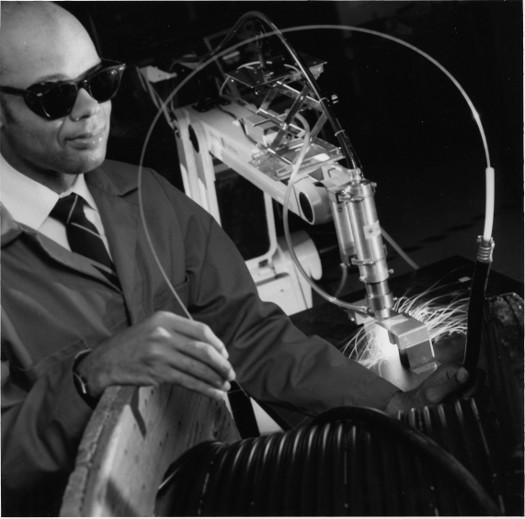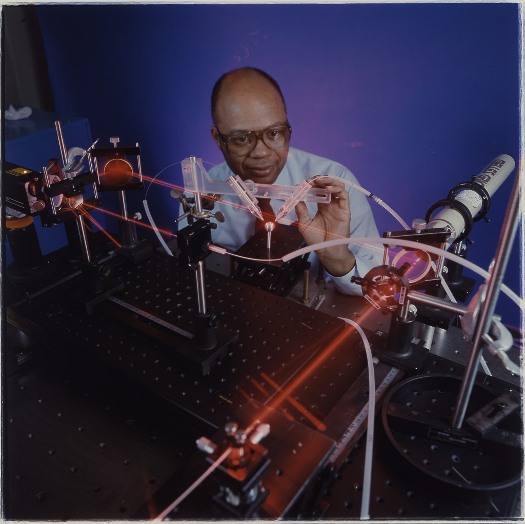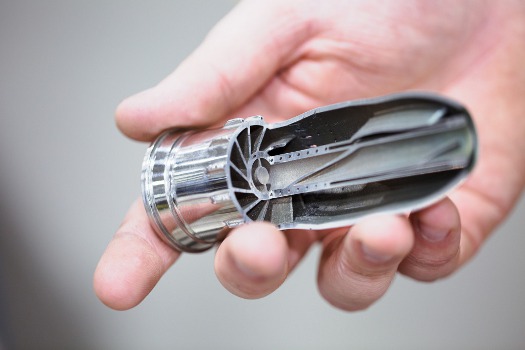 |
| April 11, 2017 | Volume 13 Issue 14 |
Designfax weekly eMagazine
Archives
Partners
Manufacturing Center
Product Spotlight
Modern Applications News
Metalworking Ideas For
Today's Job Shops
Tooling and Production
Strategies for large
metalworking plants
GE laser pioneer to be inducted into National Inventors Hall of Fame

Marshall Jones, who joined GE in 1974, became a leader in the company's laser research program and received more than 50 patents over 42 years. [Image credit: GE Global Research]
By Todd Alhart, GE Reports
Marshall Jones knows a thing or two about beating the odds, but it's not just because of his knack for mathematics. A model of perseverance, the laser pioneer was raised by his extended family on a duck farm but ended up laying the foundation for the new field of additive manufacturing, which includes 3D printing. He will be inducted into the National Inventors Hall of Fame May 4.
The institution, which counts Thomas Edison, Nikola Tesla and the Wright Brothers among its members, plans to recognize Jones for his contributions in laser technology, which have expanded the application and use of lasers. "Marshall Jones isn't just a laser pioneer, he's a trailblazer whose laser research is helping to transform manufacturing and build a new additive business for GE today," said Vic Abate, GE's chief technology officer.
Additive technologies are writing the latest chapter in the story of manufacturing. Unlike machining, this approach enables engineers to produce virtually any design they want. One application already used by GE grows jet engine parts from thin layers of metal powder by fusing them together with a powerful laser beam. Last year, the company opened a new lab studying industrial applications of the technology and also launched a new business called GE Additive. Jones' laser and other breakthroughs are now helping the industry "increase the speed, size, availability, and ease of making 3D-printed parts," Abate said.
Jones joined GE's Global Research Center after graduating with his Ph.D. in mechanical engineering from the University of Massachusetts at Amherst. He became a leader in the company's laser research program and received more than 50 patents over 42 years. This spring, Jones will be part of the 2017 class inducted into the National Inventors Hall of Fame, joining GE research giants Thomas Edison, Charles Steinmetz, William Coolidge, Robert Hall, Katharine Blodgett, Edith Clarke, and others. He's also a member of the National Academy of Engineering. "It is an incredible honor to join such a prestigious group of GE inventors and others in the National Inventors Hall of Fame," Jones said. "If I trace my steps up to this point, it has been a love of learning, having a focused set of goals, and sheer determination that has gotten me to this point and time." In other words: Never giving up.

Jones will be part of the 2017 class inducted into the National Inventors Hall of Fame, joining GE research giants Thomas Edison, Charles Steinmetz, William Coolidge, Robert Hall, Katharine Blodgett, and others. [Image credit: GE Global Research]
That seems to be the leitmotif of his life. Jones was born during World War II in Southampton on New York's Long Island, when the area was best known for agriculture, rather than summer mansions of the rich and famous. Because his father was serving in the Navy and his mother worked as a seamstress in New York City, he lived under his aunt and uncle's care on their farm.
It wasn't an easy childhood. He developed a speech impediment and, according to family lore, only his brother and the family's dog could understand his speech.
His early schooling also involved a series of setbacks. He excelled at science and raced through algebraic equations in the fourth grade. But his teacher at the time didn't believe his English was good enough and held him back. "I can honestly say that repeating the fourth grade is what helped me become an engineer," he said during a talk at Duke University in 2005. "I just wasn't learning reading and spelling at the same pace I was learning math, and I needed to take that extra year to get caught up."
Caught up he did, but his troubles weren't over. Since his family didn't have much money, Jones, who loved sports, planned to write his ticket to college as an athlete. But he injured his knee in his junior year of high school. With that avenue blocked, he attended a community college and later bootstrapped his education at the University of Michigan, where he was the only African-American student in the engineering school. He went on to earn a doctorate in mechanical engineering from the University of Massachusetts at Amherst. Years later, he self-published the aptly titled children's book "Never Give Up."

Additive technologies are writing the latest chapter in the story of manufacturing. Unlike machining, this approach enables engineers to produce virtually any design they want, including integrated cavities.[Image credit: Chris New for GE Reports]
Dale Lombardo, manager of GE's Manufacturing Processes Laboratory who worked with Jones, says that "at a time when the original 'Star Wars' trilogy and 'Superman' movies dominated people's imagination with light sabers and superheroes that could bend steel, Marshall was showing how lasers could perform amazing feats in the real world." He said that the laser applications Jones has developed "have changed the way manufacturing is done, demonstrating new ways to work with the most difficult advanced materials at a speed, cost, and quality that can't be beat."
When Jones arrived at the GE labs in 1974, he joined of a cadre of scientists who in the 1960s and 1970s pioneered research into semiconductors and lasers, including Nick Holonyak, the inventor of the visible LED, and the late Robert N. Hall, who created the first diode laser. Building on their work, Jones came up with laser beams powerful enough to cut steel, among other innovations.
Lasers are at the core of melting metal powders into place to build up parts in additive manufacturing. As industry looks to increase the speed, size, availability, and ease of making 3D-printed components, Jones' improvements in laser configuration, controls, and programming will be integral to GE's developments in new machine concepts.
Jones also remains committed to promoting STEM education for young people, particularly in underserved communities. He has spent a lot of time with fourth-graders at his old elementary school in Riverhead, NY. While at GE, he also recruits students from historically black colleges and helps them follow his own incredible journey.
He told his audience at Duke, "I am certain that my elementary teachers would not have predicted that ‘little Marshall' would be where I am today."
VIDEO: 2017 National Inventors Hall of Fame Inductee Class.
For more information about Marshall, this year's class of inductees, and the National Inventors Hall of Fame, go to http://www.invent.org/.
Read more GE Reports at www.gereports.com.
Published April 2017
Rate this article
View our terms of use and privacy policy
